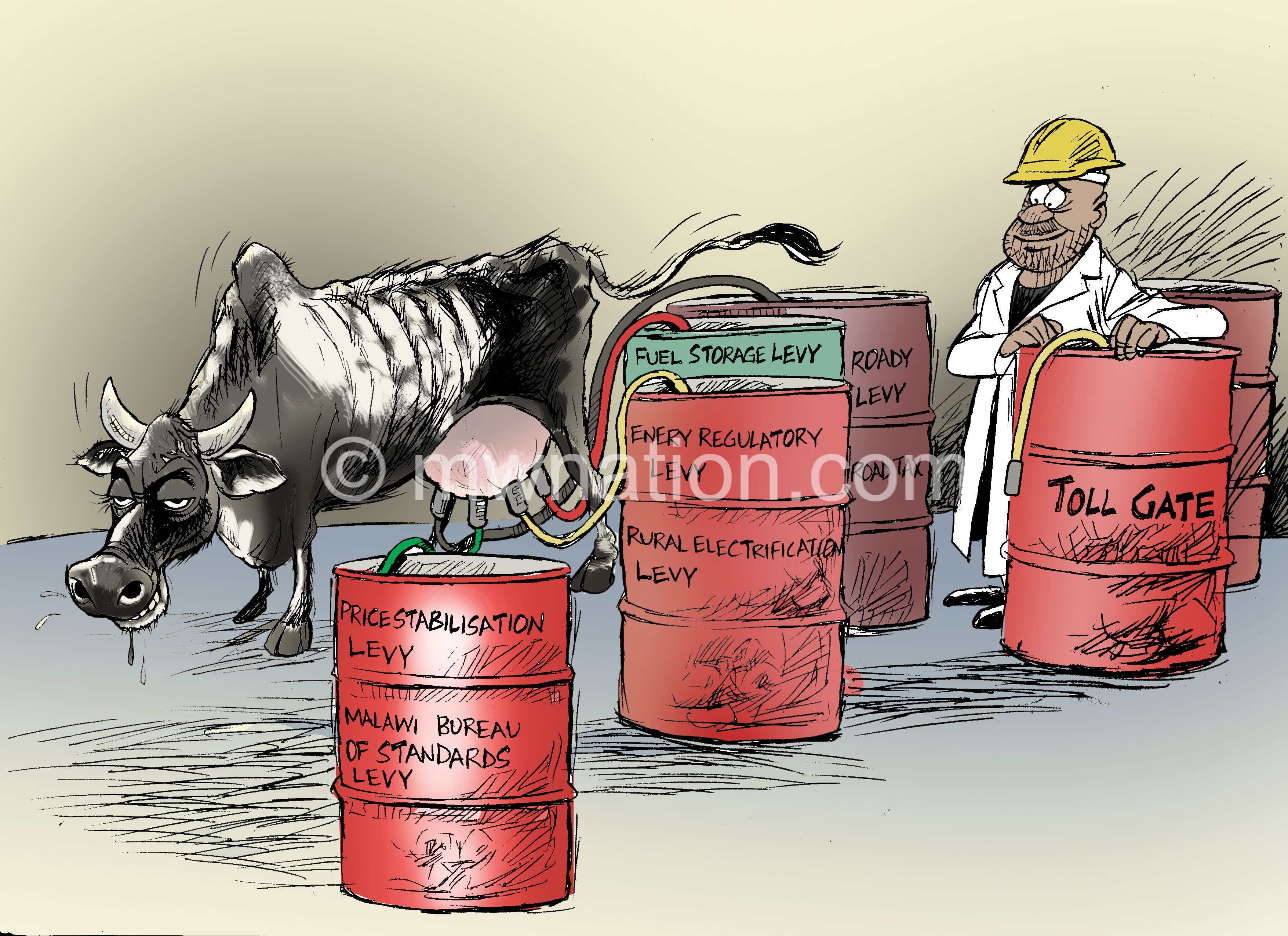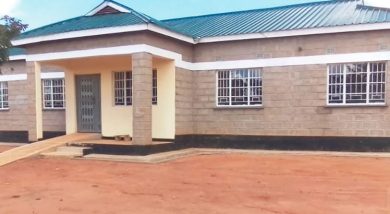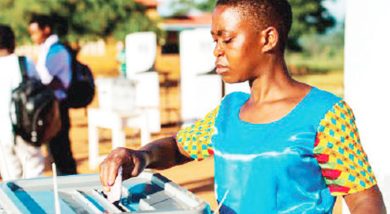Motorists groan under heavy taxes
Government is bent on squeezing the last drop of milk from the ever thinning cow—motorists—it keeps pinching money from to maintain and construct new roads.
The first pinch was stealth.
Capital Hill moved the road tax—which used to be a one-off annual payment at the Directorate of Road Traffic and Safety Services (DRTSS)—to the fuel price build-up, where motorists part with K15 as road tax for every litre they buy.
For Felix Matchado, a Blantyre-based motorist who burns roughly 100 litres of petrol per month, the change has hiked his road tax bill by at least 500 percent.
Until the shift in 2015, Matchado’s small car used to cost him a fixed K3 000, which was the annual charge for cars weighing less than a tonne.
But by paying K15 for every litre of fuel he buys, Matchado parts with around K18 000 per year based on his 100-litre monthly fuel needs; instead of K3 000.
But that is not the whole story.
According to Malawi Energy Regulatory Authority (Mera) spokesperson Fitina Khonje, the road tax was absorbed into the so-called road levy, which totals K87.5 per litre.
“The road tax collections that were being handled by DRTSS were transferred to fuel through the road levy. From the road levy, K15 per litre of petrol or diesel is remitted to DTRSS through their account at Reserve Bank of Malawi. The rest of the money from the road levy is remitted to the Road Fund Administration [RFA].”
The arrangement is lucrative for government even as it sucks motorists such as Matchado dry.
According to Khonje, Mera collected K25.8 billion during the 2016/2017 financial year, up from K19.5 billion in 2015/2016; K15.4 billion in 2014/15 and K10.4 billion in 2013/2014 fiscal year.
Even the fortunes of DRTSS have soared over time, with our calculations showing that the department received around K4 billion in the last fiscal year, over K3 billion in 2015/16, roughly K2.6 billion in 2014/15 and around K1.7 billion in 2013/14.
This is a far cry from the K600 million minimum for the 203 000 vehicles at K3 000 per tonne per year before road tax was pushed to the fuel price build-up.
DRTSS public relations manager Angelina Makwecha said the country has 203 502 privately registered motor vehicles, excluding the government fleet that cincludes vehicles for the armed forces and police.
Authorities say DRTSS uses the windfall to finance its road safety programmes, manage axle load control and weighbridges, among other operational needs.
According to RFA spokesperson Masauko Ngwaluko—who said the other chunk of the levy goes to the Roads Authority (RA)—the road levy is self-adjusting.
“The levy is self-adjusting so the levy moves with movement of other economic parameters such as exchange rate and inflation,” he explained.
Apart from the merged road levy, there is more that ails the motorist.
The country’s fuel price build-up also has the energy regulatory levy, the rural electrification levy, the price stabilisation fund, fuel storage levy and the Malawi Bureau of Standards levy.
Given that the majority of vehicle owners are what could pass for the middle class in Malawi; these are the same people who also pay the bulk of the taxes that Malawi Revenue Authority (MRA) collects as part of domestic revenue, including income taxes that are upwards of 30 percent.
But is that deterring government? No. Treasury is throwing more loads on the panting motorist.
Brace for toll gates
A new form of tax is on the cards—toll gates.
Acting director of Transport Planning in the Ministry of Transport and Public Infrastructure John Phiri confirmed in a telephone interview on Wednesday that a feasibility study report on toll gates is already out and implementation is a matter of time.
Said Phiri: “The consultant already submitted a report to the ministry. What remains now is the rolling out of the project in phases. The successful implementation of the project hinges on the provision of good standard roads on sections where the gates will be positioned. The consultant’s report also says there is need to look at adequate traffic volumes, thus implementation will be done in phases starting with the Blantyre-Lilongwe Road.”
Phiri said the toll fees had not yet been determined, but said they would be based on the vehicle weight and category.
The additional baggage on motorists comes despite concerns raised by the Malawi Confederation of Chambers of Commerce and Industry (MCCCI) in 2016, that there were too many levies on fuel while others said the motorist is paying too many fees.
But in a telephone interview on Tuesday, Finance, Economic Planning and Development Minister Goodall Gondwe put his foot down against any attempts to have some of the road levies either reduced or removed.
Said Gondwe: “The country is already lacking resources with the departure of direct budgetary support. I do not think we can afford to lose that kind of revenue. What we are saying is that we cannot remove or reduce because we are looking for money. If anything, we must find another solution, but definitely not to lose government revenue. As media, you have to help people understand the state of our economy.”
Boiling anger
But for how long can the motorist bear the burden?
Random interviews showed that people, especially motorists, are getting angry at government’s decision to push down the responsibility of taking care of roads entirely on a small portion of the population.
Said Matchado, the Blantyre-based motorist, in an interview: “We are already carrying a huge burden through various fees that we are paying at DRTSS notwithstanding the fuel levies. Now they are adding toll gates. This is not fair to people who are already struggling in a bad economy. This might work elsewhere, but government should have considered that we are already heavily taxed.”
Another highly charged motorist Richard Kaponda said public anger was building up because Capital Hill does not consult when making important decisions.
“The way government is punishing us [motorists], is as if it is a crime to own vehicles. But people are not happy with this. The economy is not performing well and the government still expects people to give it more money. There will be problems in paying toll gates because most motorists are poor. This will only be to the advantage of the rich,” he said.
Consumers Association of Malawi (Cama) executive director John Kapito, in a telephone interview, faulted government’s handling of the fuel levies.
“We have said for many times that Mera needs to be transparent in the way it handles fuel levies. This money is collected from the public and there must not be a veil of secrecy around it. What government has done is to squeeze its citizens through the transfer of the road tax, and now toll gates,” said Kapito.
Last Tuesday, Public Transport Association member Moses Chauluka accused government of making unilateral decisions on important matters such as the introduction of fuel levies and road safety regulations.
He said: “What we are worried about is that government is not in the habit of consulting major stakeholders within the sector. All these levies were introduced without consultation. This includes the introduction of toll gates.
They may have done it for a good reason, but when government becomes mean with information, it becomes worrying.”
Some economists question the sustainability of such a revenue raising strategy.
In a telephone interview on Monday, economics lecturer at the Catholic University of Malawi (Cunima) Gilbert Kachamba said the current financing model for roads in Malawi is suspect.
He said: “In the first place, the change to put road tax in the price of fuel is a burden to the consumer. We should take into consideration that not all people who buy fuel use it to run vehicles. Some use it for running machinery such as maize mills, generators and water pumps. So, to put a burden on everyone who buys fuel is inappropriate and inconsiderate.
Consequently, this just pushes the price of fuel upwards, which also forces the prices of other commodities and services to rise.”
He even wondered if the burdensome levies and taxes bring value for the money.
“Yes, we are told that the money realised from the fuel levy goes to the maintenance of roads and roads safety programmes. But if you look at it critically, the money that government gets per year is not reflected in the volume of work in the maintenance of roads and efforts to make our roads safe,” he said.
The 2017 annual economic report shows that in the 2016/2017 financial year government registered a 50.1 percent achievement on road maintenance, slightly falling behind the 2015/16 rate at 51.2 percent.
But the Ministry of Transport’s Phiri argued: “Realistically, the money that comes from the road levy cannot be enough to ensure that we are able to first maintain the current road network, which is about 4 000 kilometres, and expand it upwards. Good things do not come cheap.
In other countries, road levy fees are higher than what we have in the country. We have always relied on donors, which is not sustainable,” he said.
RA spokesperson Portia Kajanga said in an emailed response last week that the road levy is designed for “maintenance works, which include pothole patching, line marking, clearing of side drains, grass cutting, grading of earth roads and other such minor works.”
But Kajanga said the road fund money this year will be used on two roads in Lilongwe and Blantyre cities.
“In the two cities, we will be completing works on the Churchill Road in Blantyre and also expanding the Bingu Stadium to Area 18 roundabout to Parliament roundabout road in Lilongwe. Of these, the road fund will go to the two city roads that we have mentioned,” she said.





